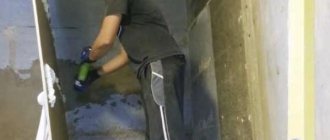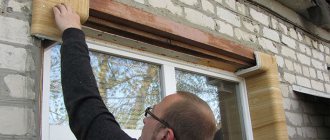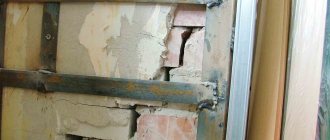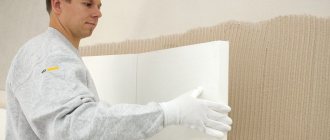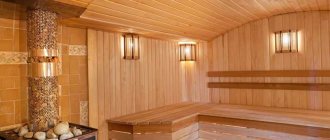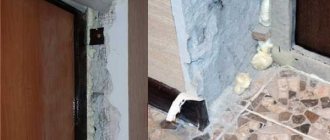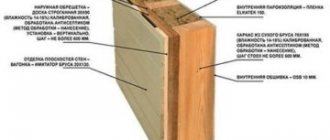Wall insulation is a necessary procedure aimed at maintaining heat in the house for comfortable living.
It has been proven that in the cold season, about 30% of all heat loss occurs due to uninsulated or improperly insulated walls.
No matter how powerful and modern the heating system is, without proper insulation of the walls, the effect of its use will be minimal.
There are two ways to insulate a house - outside and inside.
Internal insulation is applicable in cases where it is necessary to preserve the original appearance of the building (for example, an apartment in a high-rise building, or a unique facade of a house). One of the most effective materials for insulation is mineral wool.
If for some reason mineral wool is not suitable for you, you can choose insulation from these materials:
- Styrofoam;
- extruded polystyrene foam;
- penoplex;
- penofol;
- penoizol;
- polyurethane foam.
Features of internal insulation
Unfortunately, internal insulation is not as effective as external insulation of premises, but with the right approach it can be a good way out of the situation. The main problem with this method is that the load-bearing wall itself, bordering the street, does not become warmer.
IMPORTANT!
The so-called “dew point” (the boundary of the cold wall and the insulation layer) shifts to the surface of the finishing layer , which inevitably leads to the appearance of dampness and the eventual destruction of the wall and finishing layer. These negative consequences can be avoided during internal insulation by using special hydro- and vapor-tight membranes.
At the same time, despite its disadvantages, insulating walls from the inside also has its positive aspects:
- such work can be done with your own hands;
- insulation of internal walls with mineral wool can be done at any time and in any weather;
- there is no need to complete all the work at once - it can be done gradually;
- Insulation with such a device plays the role of sound insulation and prevents extraneous street sounds from entering the home.
Pros and cons of insulation methods
Useful tips and nuances of internal insulation
If possible, it is advisable to carry out insulation from the outside, as this is most effective. In addition, this allows you to neutralize the harmful effects of cold on the walls. Naturally, this does not apply to wooden buildings, where it is necessary to lay a thermal insulation layer both inside and outside the room.
Experts recommend that before installation work, a calculation of the thermal characteristics of the building is carried out, thanks to which it is possible to correctly select the thickness and characteristics of the insulation. Even when individual sections of the walls freeze, they provide thermal insulation around the perimeter of the entire room. If the building has high humidity, then foil insulation is used.
When doing all the work with your own hands in a brick or wooden building, it is important to ensure that the markings are applied correctly. The rolled insulation must be opened in advance so that the mineral wool takes on its original dimensions.
If glass wool is used as insulation, then all work on its installation is carried out only with the use of protective equipment. You cannot proceed to the main work until the fungus and mold, as well as other damage to the walls, have been eliminated in the room.
Many experts also recommend laying insulation under the metal profile or using polyurethane foam. Mineral wool must be properly leveled so that it acquires its natural position without dents, deflections or waves. In the case of multi-layer laying of thermal insulation, the seams should not be allowed to coincide.
Mineral wool
Mineral wool as a building material used for insulation has been known for quite a long time.
Made from natural basalt fibers, it is environmentally friendly and retains heat well inside a wooden or brick house.
There are 3 main types of mineral wool, depending on the intended use:
- lungs . Used in frame insulation. Their density ranges from 10 to 90 kg/m3;
- heavy . This type of wool is used to insulate building facades. Its density is 90 kg/m3;
- technical _ They are used mainly for insulating industrial premises and equipment where high and low temperatures are observed.
Mineral wool also comes in several types according to its composition:
- glass wool - produced by melting quartz sand or broken glass into thin fibers. When adding binders, it acquires the usual yellowish color. This material does not burn and does not change its properties when it gets wet;
- slag wool - made from industrial slag waste. The use of such wool when insulating residential premises is unsafe from an environmental point of view;
- basalt wool is the most common material for home insulation. It has an increased thermal conductivity coefficient.
- stone wool is one of the most technologically advanced options. It is practically free of drawbacks and is often used in construction; this option is recommended for internal insulation.
Comparative characteristics of insulation materials
Proper insulation of the walls of a frame house with mineral wool in detail and step by step
It is worth noting that mineral wool is a very good material for insulation, but it still has several negative parameters, such as the release of harmful substances, which limits its use indoors.
It is also noted that the material is afraid of moisture and water vapor.
If the mineral wool is saturated by even a few percent, the insulation loses half of its heat-insulating properties.
Now you should highlight several basic steps for insulating walls with your own hands when using mineral wool:
- First, it is necessary to sheathe the inside of the structure with a vapor barrier material;
- Then sew up the inside of the frame, often using OSB. In this way, niches are created for further sealing;
- Usually niches are made to the size of mineral wool, but if necessary, you will have to trim the sheet with a simple knife. It is worth considering that you should cut 5 mm more on each side than was measured, this creates additional protection against possible cracks;
- Selecting the number of mineral wool sheets. Each is 5 cm thick, the calculation must be made based on the terrain, in normal cases 2 sheets are enough. Sometimes niches are made in several layers that intersect;
- Now the frame is sheathed on the outside with wind protection;
- The sheathing goes on top of the insulation.
Installation of mineral wool
Laying insulation
Advantages and disadvantages of mineral wool
The spread of mineral wool is primarily due to its advantages:
- low thermal conductivity;
- non-flammability;
- mechanical stability - does not change its properties when exposed to it;
- soundproofing characteristics;
- resistance to temperature deformation;
- biochemical resistance;
- convenience and ease of installation.
However, despite the impressive list of advantages, building regulations do not recommend using ordinary mineral wool for insulating premises . This is caused by the presence of phenol in its composition, which has a detrimental effect on human health. For internal insulation, craftsmen advise using ecowool or stone wool.
If installed incorrectly, exposed areas of mineral wool come into contact with the ventilation system, resulting in hazardous particles being released into the surrounding air.
NOTE!
When working with mineral wool, it is mandatory to use gloves and a respirator!
What you need to know about mineral wool?
Mineral wool for wall insulation can be of three types, it all depends on what source material was used to make the wool.
Based on glass fiber (glass wool)
The raw material for the manufacture of glass wool is glass, but not more than eighty percent. The composition also includes sand, borax, soda and limestone. Fiber thickness is from 5 to 15 microns, length is 15 – 50 mm. Withstands temperature loads from – 60 to +450° C.
Advantages and disadvantages:
- Has increased elasticity. The material can be folded in several layers without it deteriorating;
- Vibration resistance;
- Excellent moisture resistance. This material is practically waterproof;
- The purity of the material and the absence of toxic components, hence minimal harm to the human body;
- Fire resistance. The material is absolutely non-flammable;
- Not susceptible to mold or mildew. Mineral water does not rot;
- Absolutely inedible for rodents (rats, mice);
- Enhanced safety precautions are required when handling the material;
- Some types contain formaldehyde.
Based on slag (slag wool)
The raw material for the production of slag wool is metallurgical slag, which is processed into glassy fibers. It has a fiber thickness from 4 to 12 microns, and a length of 16 mm. Among all types of mineral wool, this type can withstand the lowest temperature - 300° C.
Advantages and disadvantages:
- Has high chemical resistance;
- Simplicity and ease of handling during installation. Cotton wool is produced in rolls;
- Environmentally friendly. The material contains a minimum amount of components harmful to the human body;
- Not resistant to high temperatures. At temperatures above 300° C, the fibers begin to melt and the material loses its performance qualities;
- Hygroscopicity and residual acidity;
- Fiber fragility. The fibers crack and dust from them appears in the air.
Based on stone fiber (stone wool)
The raw material from which this material is produced is rock, namely: gabbro-basalt, metamorphic rocks, marls. The thickness of the fibers almost corresponds to the size of the slag wool fibers.
Stone wool products can withstand very high temperatures, provided the material is not deformed. Wool fibers can withstand temperatures up to 1000° C. Unlike glass and slag wool, stone wool's fibers are not sharp, which makes it easier to handle.
Advantages and disadvantages:
- Has low thermal conductivity. Keeps the house warm;
- Has a very long service life. Shelf life up to forty years;
- The material is not afraid of exposure to mold;
- Has high noise insulation properties;
- Resistant to vibrations;
- Eco-friendly material;
- Has high fire safety;
- Convenient for installation;
- High price;
- There may be heat leakage through the seams. To avoid this, it is necessary to connect the wool slabs together as tightly as possible;
- Does not withstand heavy mechanical loads.
Drywall
Today it is difficult to imagine renovation without the use of drywall. It is multifunctional and is used for finishing walls, ceilings, creating partitions, and various decorative elements.
Some types, due to their water-repellent properties, are used in finishing bathrooms and toilets.
Before using drywall, you need to understand its positive and negative characteristics in order to understand the specifics of handling it.
Advantages of drywall:
- Flexibility and lightness . The use of this material allows you to implement the most daring design solutions. It is easy to make various geometric shapes from it - from banal rectangular to complex semicircles, arches, columns;
- Thermal insulation properties;
- Fire resistance . Drywall doesn't burn. When it is exposed to fire, only the top paper layer suffers.
- Water resistance . Special types of gypsum boards have been developed that are recommended for use in rooms with high humidity.
Disadvantages of drywall:
- The main disadvantage is its fragility . A sheet of drywall can easily be damaged during transportation, installation, and subsequent operation;
- Soundproofing characteristics . Drywall does not have soundproofing properties. Behind a simple gypsum board partition all sounds will be heard.
Drywall
List of the best materials
To insulate walls under drywall, the following types of insulation are used:
- Styrofoam;
- glass wool;
- isolon;
- basalt wool.
They differ from each other in technical indicators and pricing policies. Based on this, the choice of material should be made in advance, before work begins.
Extruded insulation
The material consists of foamed polystyrene granules. It is characterized by low density and light weight; slabs of various thicknesses can be found on sale. The material is popular because of its affordable cost, it is convenient to install even without a frame, and it is on sale almost everywhere, in most repair stores. There are also some disadvantages:
- low level of sound insulation;
- raw materials do not allow air to pass through and require ventilation;
- fragile and unable to withstand damage;
- Rodents can settle in the material, which will damage the insulation and require its dismantling and replacement.
Glass wool
The material is soft and flexible, relatively thin, which helps save space. The thermal conductivity coefficient is low, the cost is affordable. However, do not forget about the specifics of the insulation; its installation may be unsafe for health. When glass wool fibers come into contact with mucous membranes and skin, they cause a burning sensation and unbearable itching. Installation work should only be carried out using special clothing: a respirator, safety glasses and gloves. These inconveniences make the demand for glass wool not too high.
Izolon
A new type of insulation, consisting of polyethylene foamed with propane. It weighs little, has low density and contains a large number of air bubbles. This allows you to successfully retain heat in the room and increase the level of sound insulation. Its thickness is insignificant and saves useful living space. Some manufacturers produce isolon immediately with a thermal protection layer consisting of foil. If such a layer is missing, you can create it yourself by attaching construction foil to the isolon using glue.
Basalt wool
The cost is higher than glass wool and foam, but it is offset by other advantages. First of all, it is a natural material, which is created using a melt from rocks. Distinctive qualities:
- natural;
- does not cause allergies;
- high strength;
- fire resistant.
The composition includes a large number of stone fibers of small thickness. The presence of an air gap between them determines the excellent thermal insulation properties of the material. Another important difference from other types of mineral wool is its inability to absorb moisture, which allows it to be used even at high humidity.
Construction of a wall pie from the inside
In construction, the totality of all structural elements is usually called a pie. In relation to internally insulated walls, the structural pie looks like this:
- external load-bearing wall;
- waterproofing;
- insulation layer - mineral wool;
- vapor barrier membrane;
- drywall frame;
- finishing plasterboard sheets;
- finishing finishing material.
wall pie
Vapor barrier - description and installation
An important step in the process of internal wall insulation with mineral wool is the installation of a vapor barrier. During the operation of a residential building, steam is constantly released during cooking, using the bathroom, and using the kettle.
In this case, steam easily penetrates through the layer of drywall into the insulated partition. If the surface of the mineral wool is not covered with a vapor barrier membrane, you may encounter the fact that the insulation, which has absorbed a large amount of moisture, will become a constant source of dampness and mold.
The vapor barrier is installed on top of the frame with a layer of insulation. There are 2 types of material designed to create a vapor barrier under drywall, the first of them is polyethylene film . It is the most budget option. However, in addition to retaining steam, it does not allow air to penetrate into the partition space, which is fraught with the formation of a greenhouse effect and eventual dampening of the drywall.
Mineral wool vapor barrier
Membrane film is an innovative material in this regard . This film easily retains moisture, but does not interfere with air ventilation. The membrane film “works” only in one direction. This is important to consider when installing it.
The film covers the entire surface of the finished partition. The canvases should be laid overlapping, the joints should be taped with mounting tape.
Lathing under mineral wool and drywall - features and installation
Traditionally, you can create a partition sheathing for attaching drywall from two materials:
- wooden slats;
- galvanized profile.
The wooden frame is distinguished by its massive, bulky design. Before installation, wooden slats are treated with an antiseptic to prevent the possibility of rotting.
When installing drywall, it is more advisable to use special galvanized profiles.
They are designed to be attached to each other, in addition, they are provided with mechanisms for attaching to walls - brackets, with which you can adjust the thickness of the partition.
A brief diagram of the installation of lathing for gypsum boards can be presented as follows:
- The thickness of the partition is determined depending on the selected thickness of the insulation;
- a guide profile is attached to the sides of the vertical adjacent walls, along the floor and ceiling;
- the edge from which the plasterboard sheets will be installed is determined;
- Considering the width of the sheets is 120 cm, markings are made every 40 (or 60) centimeters;
- U-shaped brackets are attached along the markings at intervals of 50 cm;
- the supporting posts are inserted into the guide profile in accordance with the markings;
- using a stretched string, level the supporting posts and secure them with brackets;
- Transverse posts are attached to the load-bearing posts to ensure structural rigidity;
Mineral wool lathing
Insulation is laid under the resulting plane.
Preparation process and installation
First of all, it is necessary to prepare the walls - to do this, repair cracks and peelings, treat the surface with an antiseptic to avoid the appearance of mold. If there is already fungus on the walls, dry the wall before starting work. A hair dryer will do a better job of this, and after drying, remove the fungus with a scraper and treat it with special means.
The next stage is building the frame. The thickness should be equal to the thickness of the insulating layer. Deviation from this indicator leads to damage or protrusion of the plasterboard into the room, and insufficient thickness will not allow the wall to be properly insulated.
Finished frame and laying of mineral wool
The horizontal and vertical distance between the slats is made smaller than the size of the mineral wool. It is sold in the form of sheets or rolls. This is done so that the mineral wool can tightly occupy the space allocated to it.
Do not forget about the size of the drywall sheets. A distance of 1200 mm is maintained between the slats, which is usually the width of a sheet of plasterboard; in addition, one or more intermediate elements will be installed in this space.
The next stage is the installation of a vapor barrier film. To fix it on the wall, use a staple gun to secure it with staples. However, places of damage or punctures are covered with tape, otherwise moisture will appear in these places.
The remaining space in the frame, which remains between the slats, is filled with pieces of mineral wool.
If the cotton wool is used not in sheets, but in rolls, cut off fragments slightly larger than the available space - wool tends to deform, so a precisely measured piece may simply not be enough.
Insulation of walls from the inside with mineral wool plus plasterboard
IMPORTANT!
Any thermal insulation work should begin with surface preparation.
All irregularities and depressions must be plastered and filled. Walls that are to be insulated are treated with anti-mold preparations and primed.
Insulating a brick wall from the inside with mineral wool:
- Using the method discussed above, a sheathing is created in addition to securing the load-bearing posts;
- insulation is being prepared. The method of its fastening depends on what kind of mineral wool you are dealing with . It is convenient to string cotton wool in the form of mats onto brackets installed in the wall. Laying should be carried out so that there are no gaps between the mats. ;
- after filling the walls with insulation, load-bearing racks are installed;
- If mineral wool is purchased in rolls, its installation can be done after installing the racks. It is easy to fill the space between the racks and the wall;
- the surface of the insulation and sheathing is covered with overlapping rolls of vapor barrier membrane. The membrane joints are glued with mounting or plumbing tape .
Insulation scheme
Laying the material
This way there is a prepared surface for mounting plasterboard sheets.
Waterproofing
The need for waterproofing arises in wooden houses with log walls with cracks and cracks. In order to prevent contact of street air with the insulation layer, wooden walls are covered with a layer of hydro- and windproof membrane.
This film reliably protects the insulation layer from moisture from the street. It is attached using a stapler and overlapping staples, the joints are glued.
Wall waterproofing
Installation of drywall sheets
The installation diagram for drywall is simple:
- The sheets are fastened to the frame using metal screws. The standard length of gypsum board is 250 cm. If the height of the room is greater, a piece of the required size is cut from a new sheet. In this case, the installation of sheets is carried out staggered - so that the position of the segments alternates.
- If necessary, a second layer of plasterboard is installed.
- The drywall is being cleaned.
Installation of gypsum boards


